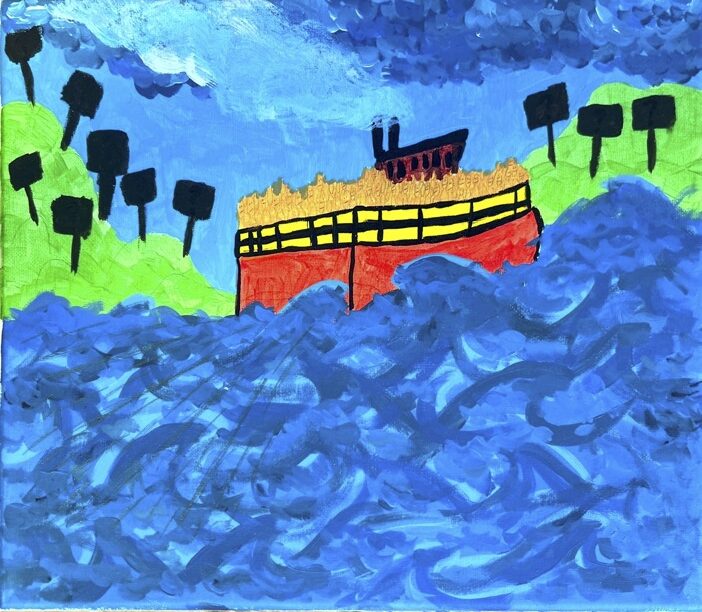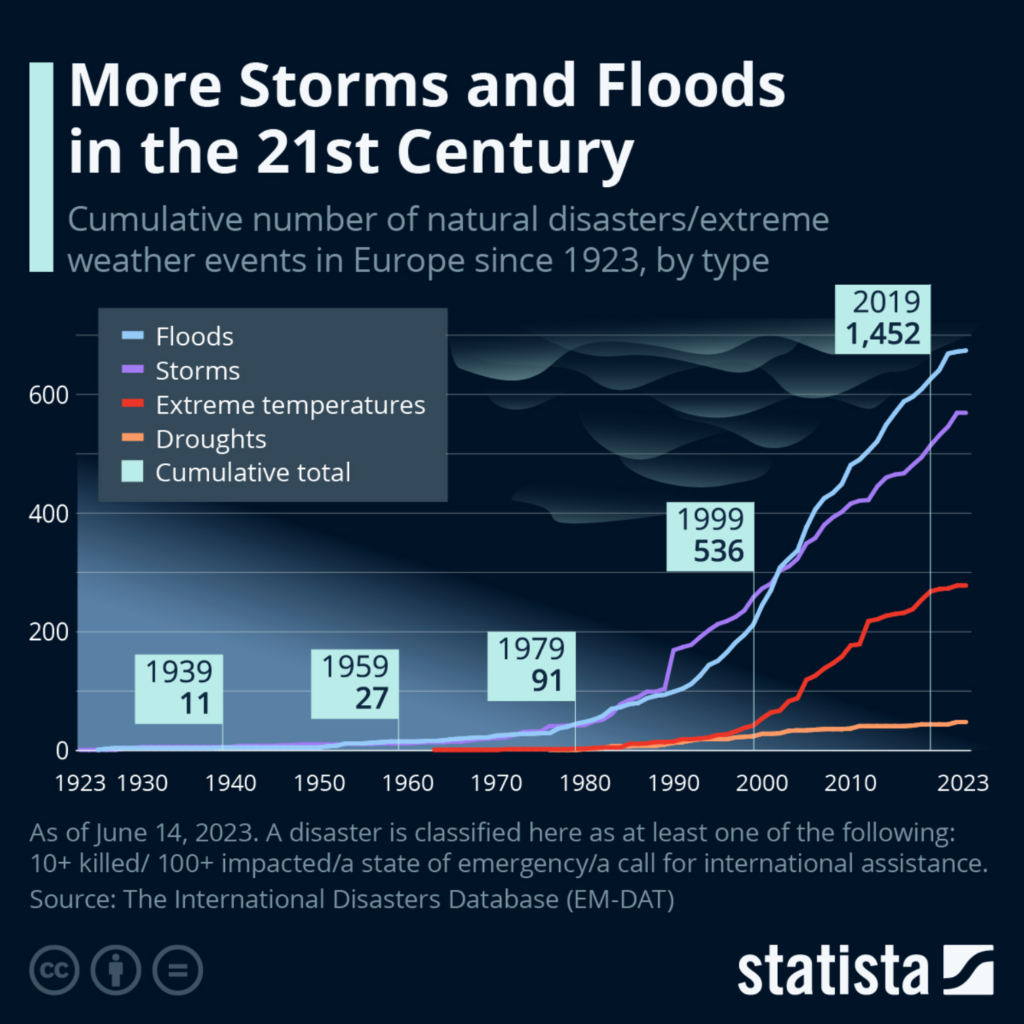Climate migration has begun.

Art piece: A boat of climate refugees is going towards a new land. The posts have question marks on them, denoting that the refugees do not know where they will end up eventually. Also, the water is tumultuous and angry, showing that the refugees have traveled through a rough area and have rough travels ahead.
Since 2008, 376 million people have been forced to leave their homes due to climate related issues. The number of climate refugees reached its peak in 2022 at 32.6 million. It is estimated that 84% of total refugees fled from their home countries due to climate related disasters that year (“Refugees.” United Nations).
Yet climate refugees remain “forgotten victims” due to the lack of recognition and government aid into helping them immigrate to safer locations (Chitrangada and Yasudhara 2023).

Source: Fleck, 2023.
Climate Refugees’ Historical Lack of Recognition
In 1948, the Universal Declaration of Human Rights stated that “everyone has the right to seek and to enjoy in other countries asylum from persecution.” This formed the initial and most commonly used definition of a refugee internationally.
Lester Brown, an American environmental analyst, went on to coin the term ‘environmental refugees’ in 1970 to describe people forced to leave their homes due to an “environmental disruption” that significantly affects their lives and quality of living (Berchin et al. 2017).
Although Brown helped to raise awareness, this term still is not officially recognized by any countries. Environmental refugees do not fit asylum stipulations that they suffered persecution or live in fear of future persecution (Berchin et al.). This lack of recognition prevents them from gaining refugee status when crossing borders into a new country.
Source: Elevate
Coerced Migration
The environmentally displaced increasingly need help finding habitable places to live. In many cases, the environmentally displaced live on small islands, such as Haiti, Barbados, and Singapore, which among are the most vulnerable to climate change due to the rapidly rising water levels and increasingly severe storms (Berchin et al.).
As Rana G. Ksaifi, the United Nations High Commissioner for Refugees (UNHCR) Assistant Chief of Mission in Libya described on a visit to Derna, Libya after severe flooding in the fall of 2023, the city was “washed away” after two large dams burst due to heavy storms and rainfall. 30,000 people were displaced in Derna due to this extreme flooding.
One woman she interviewed, Amal, recounted the evening of the flood:
‘I woke up at around 2 a.m. to the noise of cars smashing into one another. It was such a strange sound to wake up to that I thought I was dreaming…I looked up in panic at one of my daughters who was sleeping under a window and ran to grab her before she was hurt by whatever it was that I knew was coming our way. But I never made it.’
She never saw her three daughters again (Ksaifi 2023).
Source: Al Houdiri, 2023.
Another citizen of Derna recounted how she lost 21 members of her family that day (Ksaifi). Many of the families in Derna had to live in compounds specifically designated for flood victims. The damage escalated too fast for volunteers and UNHCR members to help.
Many of the issues that these families experience go beyond a destroyed home; in the future, they will also need psychological help to cope with the severe mental damage that comes from losing your home, all personal belongings, and family members. Moreover, such low-lying areas remain vulnerable to future storms and flooding, due to climate change.
These types of stories are echoed throughout affected countries and areas like the Gobi Desert in China, Morocco, and Tunisia. In these areas, locals are forced to relocate due to the severe drought that slowly diminishes the amount of farmable land (Boudreau, Diane, et al. 2024). Both the land where they live and their everyday lives of these people are impacted so they are forced to leave.
What can we do?
The number of climate refugees continues to climb. Due to the rapidly changing climate, there will be an estimated 150 million total environmental refugees around the world by 2050 (Berchin, et al.). People that are currently living in stable countries and nations still have a long way to go in terms of helping these refugees and our world stay afloat. It is important to act quickly to reduce the impact of climate change by expanding legal categories of who counts as refugees. However, we need help from the government to assist these refugees through implementing helpful policies.
References
Ahmed Al Houdiri. 2023. In [Ksaifi, Rana G. September 28, 2023. “Survivors find strength in community after horror of Derna floods.” United Nations High Commissioner for Refugees. Retrieved April 1, 2024 (https://www.unhcr.org/us/news/stories/survivors-find-strength-community-after-horror-derna-floods).]
Anna Fleck. June 27, 2023. “More Storms and Floods in the 21st Century.” Statista. Retrieved April 23, 2024 (https://www.statista.com/chart/30288/cumulative-number-of-natural-disasters/)
Apap, Joanna and Sami James Harju. 2023. “The concept of ‘climate refugee’: Towards a possible definition.” European Parliament. Retrieved April 11, 2024 (https://www.europarl.europa.eu/RegData/etudes/BRIE/2021/698753/EPRS_BRI(2021)698753_EN.pdf)
Berchin, Issa Ibrahim, Isabela Blasi Valduga, Jéssica Garcia, and José Baltazar Salgueirinho Osório de Andrade Guerra. 2017. “Climate change and forced migrations: An effort towards recognizing climate refugees.” Geoforum. Retrieved March 7, 2024 (https://www.sciencedirect.com/science/article/abs/pii/S0016718517301732)
Boudreau, Diane, Melissa McDaniel, Erin Sprout, and Andrew Turgeon. January 22, 2024. “Environmental Refugee.” National Geographic. Retrieved April 21, 2024 (https://education.nationalgeographic.org/resource/environmental-refugee/#)
Chitrangada and Yasudhara. 2023. “Rising tide of climate refugees.” The Pioneer. Retrieved March 7, 2024 (https://advance.lexis.com/document/?pdmfid=1516831&crid=4fcf4e61-52bb-45b9-bb45-d3ff30973119&pddocfullpath=%2Fshared%2Fdocument%2Fnews%2Furn%3AcontentItem%3A6B0F-NTH1-F12F-F4TN-00000-00&pdcontentcomponentid=332051&pdteaserkey=sr0&pditab=allpods&ecomp=tmnyk&earg=sr0&prid=5c5d86c7-c05c-4694-a764-76ada3afc093)
Elevate. Retrieved April 2, 2024 (https://www.elevatelimited.com/insights/newsletters/do-you-know-a-climate-refugee-you-will/).
Ksaifi, Rana G. September 28, 2023. “Survivors find strength in community after horror of Derna floods.” United Nations High Commissioner for Refugees. Retrieved April 1, 2024 (https://www.unhcr.org/us/news/stories/survivors-find-strength-community-after-horror-derna-floods).
McNamara, Karen Elizabeth and Chris Gibson. 2009. “‘We do not want to leave our land’: Pacific ambassadors at the United Nations resist the category of ‘climate refugees’.” Geoforum. Retrieved March 7, 2024 (https://www.sciencedirect.com/science/article/abs/pii/S0016718509000335)
“Refugees.” United Nations. Retrieved March 7, 2024 (https://www.un.org/en/global-issues/refugees)